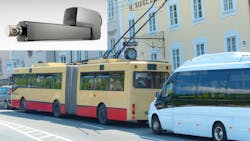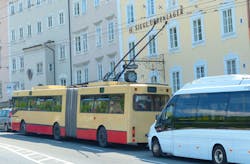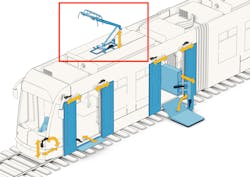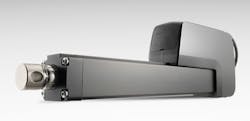Electromechanical Actuators Let Public Transit Vehicles Connect and Disconnect from Overhead Lines
Rapidly increasing demand for energy-efficient mass transit is driving increased adoption of hybrid and fully electric powered vehicles. Transit engineers have increasing needs for longer life and higher durability on components, particularly the actuators that make the safe, flexible connections to power sources. Fortunately, a new breed of electric linear actuators seems up to the task.
Actuators let electric trams, buses and trains connect and disconnect from overhead power lines when they need to. This is not as necessary for vehicles because they take all tier power from overhead catenaries. They can connect once in the morning and stay connected until the end of their day. Hybrid vehicles, on the other hand, use battery power for routes that go beyond city limits and switch back to cleaner and more economical overhead lines many times as they run their routes.
Actuators manage the overhead switching by controlling spring-loaded pantographs, the mechanical assemblies that sit atop vehicles and raise and lower to connect and disconnect with overhead lines. A spring raises the pantograph to connect and maintain contact with the overhead power line. The actuator pulls the pantograph away from the power lines when switching to battery power. In some designs, the actuator also pre-loads the spring that raises the pantograph. More efficient intermittent switching reduces the need to add unsightly and potentially dangerous overhead wiring within city limits as mass transit use increases.
Other designs rely on pneumatic actuators to raise and lower the pantograph, but air compression emits moisture that can cause clogging and, in low temperatures, icing. Pneumatic devices also need more components, including pumps, pipes and a source of compressed air.
Actuators also guide the switching in recharging stations, helping hybrid buses get the power they need to operate during the day. And for trains that get power from third rails, actuators are used to extend the contacts from the train to the powered rail.
Where existing applications might need actuators with lifetimes of 20,000 to 30,000 cycles, increased ridership could raise the estimated life for actuators into the 500,000-to-1 million cycles range. Extending actuator life requires engineers to consider at least four issues: ball screw selection, motor design, braking and environmental resistance.
Actuators in mass transit applications translate rotational motion into linear motion through a ball screw. Selecting a ball screw that can handle a million cycles requires balancing the load and speed by upgrading the nut and screw. This can be quite complex but essentially involve increasing the screw and nut’s load capabilities by using larger diameter ball screws and a nuts and twice the number of rolling ball bearings.
Motor design also affects actuator life. Most actuators on electrified vehicles use traditional contact-brush-based DC motors. But brushes wear out much too soon for the extended use transit designers are projecting. A better alternative is to replace the brushes with an electromagnetic field, which eliminates contact brushers and can last virtually forever. There will, of course, be some wear on bearings and other parts of the motor, but its longevity no longer depends on brush life. A brushless DC motor also requires a slightly different user interface and will help control braking in pantograph operation.
In a pantograph, the actuator works against a spring. In one direction, it opposes the spring; in the other, it assists the spring. An opposing spring provides stable, more controlled speed in one direction. An assisting spring, on the other hand, allows a more free-wheeling operation that must be controlled. Typically, speed is controlled with a friction brake when the spring is assisting. In the case of extended use, friction brakes wear down and limit the actuator’s life.
Along with an upgraded motor, the new actuator should be mated with an upgraded ball screw, an electromagnetic load holding brake and an electronic motor control. This lets the brushless motor control the speed while an electromechanical brake holds the load in place once the actuator stops.
Actuators for public transit applications are already subject to health and safety regulations, but expanded use will bring greater improvements there as well. Vehicles in less-frequent operation might get away with using components rated as low as IP65 on its protection against contaminants. But wider use of trains travelling 62 mph (100 kph) means greater exposure to the environment which will likely require more protection. Likewise, operations in seaside communities increase exposure to corrosive salt air and would also call for more protection, likely IP66 or even IP69K. These factors, combined with stringent public safety standards preventing use of toxic materials, are driving actuator suppliers to make certain the materials and seals will perform safely for 20 or 30 years, the expected lifetime of the vehicles.
In today’s transportation applications, actuators primarily provide the switching—something they will continue to do. But switching requires some onboard electronics, which lets actuators communicate with each other and other devices. This networking gives operators information such as the position of the pantograph. So, actuators will need to be improved.
Although actuators used for charging stations are among the first components that must be upgraded to accommodate growing ridership and expanded electrification, other actuator applications may soon follow, including door operation, step levelling, rail car connecting and gap control for safe and easy passenger access. Until today, these applications have primarily been powered by pneumatic or hydraulic actuators, but with increased cycles and the need for more efficient and durable components, engineers should consider the better-suited electromechanical actuators for their designs.
Travis Gilmer is product line specialist for industrial linear actuators at Thomson Industries, Inc.



